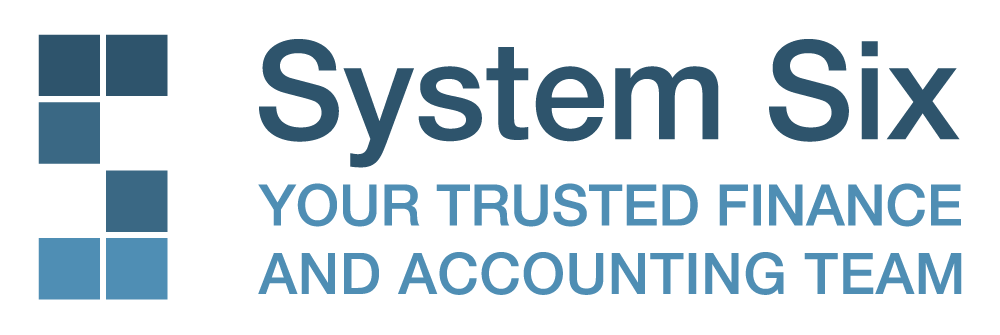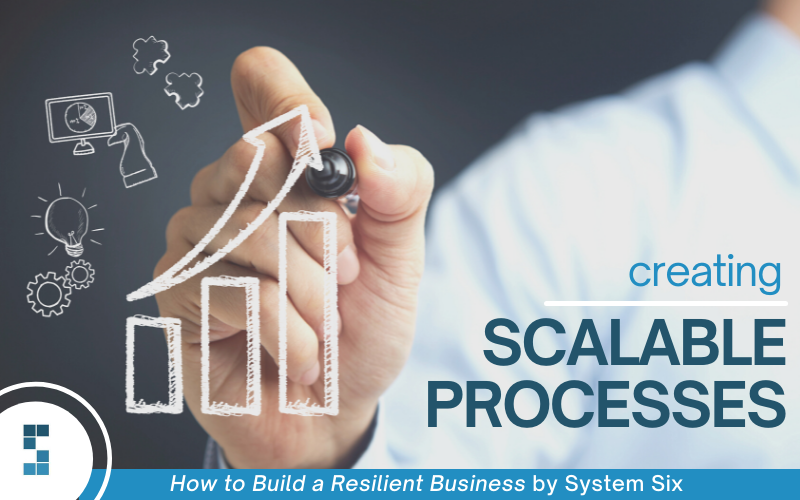
by Chris Williams | Mar 15, 2022 | Blog
Imagine for a moment that you own a pizza restaurant and have employed a talented team of chefs – but you fail to give them a step-by-step, process-driven pizza recipe to follow. What kind of product would your restaurant be delivering to your clients?
The fact is, even if you have an excellent vision for pizzas and Michelin-star winning chefs to make them, you would be highly unlikely to deliver consistent results without a recipe for your team to follow.
The same principle is true for business. You can have a solid mission, vision, and values statement and an amazing team of gifted people to carry it out. Still, without scalable processes for your team to follow, you risk delivering inconsistency in the quality of your products and services.
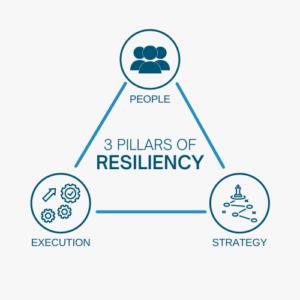
Execution – how you cook the recipe – is our third pillar of a resilient business.We believe excellent execution demands the creation and implementation of repeatable, scalable processes for your team to lean on and follow.
Why Processes Matter
It wasn’t until several years after launching System Six Bookkeeping that we began to truly realize the value and impact of creating and implementing processes for our company.
We had team members who used various preferred tools and strategies to stay on task and organized. Some employees preferred online resources, like Asana and Trello. In contrast, others preferred using an old-fashioned notebook, planner, and pencil to plan out and keep track of their work and schedule.
While these tools and strategies might have worked well for the individual team members, we realized not having a universal, centralized system would invariably cause inefficiency, confusion, miscommunications, and inconsistent quality for our customers.
It’s not enough to simply assign your team tasks and expect them to get the work done however they best see fit. Even if they ultimately produce good work using their own methods, your overall execution will lack the efficiency and cohesion necessary for a successful, resilient business.
It’s ultimately on your leadership’s shoulders to create and implement the right processes to set your team and your company up for success.
Step One: Creating Processes
We believe the same thoughtful intentionality you took to write out your mission, vision, and values statement should be applied to writing out your company’s scalable processes.
Take time, and if necessary, get away with your leadership team to work through and write down these important steps. Keeping your mission and values close to heart, write out the processes you want your team to execute.
What will your hiring process be? What steps are necessary for your team to follow in onboarding new staff and new clients? What is your month-close process?
No detail is too small as you create the processes your team will follow. Think through each element of your teams’ responsibilities and your clients’ journeys – is there a documented, clear pathway? Is there a consistent way to teach and train your team these steps?
Step Two: Implementing Processes
It’s important to note that when it comes to implementing processes, what works for a small, local team of 5-10 employees won’t necessarily work as well for a global team of 15 + remote employees.
For smaller teams working in the same office, a shared spreadsheet of word docs or a database of processes your team can access and share via cloud might be just the right avenue for implementation.
For larger teams, especially those with remote employees working from different locations and time zones, we are big fans of resources like Karbon, a workflow management software, to integrate team communication and collaboration.
Your leadership team can choose from many other cutting-edge tools and technologies to make accessing and implementing your company’s processes as easy as possible. Training and equipping your team is a critical component for success. Take time to ensure your onboarding includes thorough training on your programs and expectations for use.
Additionally, allowing your team members to provide regular feedback, criticisms, and improvements to your processes will build buy-in and ownership of your operations. Since your employees work in and out of these systems daily, provide pathways for them to provide input.
From thoughtfully writing down the processes that make sense for your business to adopting smart tools and technologies to make following those processes as natural as possible, you are setting your team up to execute your mission, vision, and values with excellence and success.
Join us next time as we dig into how to curate successful rhythms for resilient execution.

by Chris Williams | Feb 22, 2022 | Blog, Leadership
Attracting great talent is a key strategy to building a resilient business. Retaining that talent is equally important. The Great Resignation has opened our eyes to the importance of creating environments where employees can thrive. People aren’t only looking for robust retirement packages or attractive benefits portfolios; they want a strong company culture. Employee retention is at critical mass.
How does your team experience the place in which they work? Are they stressed and frazzled? Are their coworkers inclusive and diverse, or is it a competitive, homogenous environment? Do you actively support the work-life balance your employees desire? (Here are some signs your team is overwhelmed!)
A resilient work culture begins and thrives through attentive leadership that listens to their teams’ concerns and gives them the support they need to be successful.
Prioritize a Great Culture From the Start
All too often, unfortunately, companies confront their workplace cultures reactively instead of proactively.
Leadership coach and SSB client Aiko Bethea recently brought attention to this in her conversation about transformative workplace cultures with Brene Brown on the Dare to Lead podcast. “When something is important to you, and you value it, not only is it a priority, but it’s something you’re going to deal with intentionally.” Bethea goes on to say that companies often view priority through the lens of “yesterday” – reactively trying to fix issues instead of proactively working towards a better future.
Leaders who reactively rush into action to put out fires without being prepared or equipped can do more harm than good. Excellent workplace culture develops when employers intentionally support their teams from their first moments on the job.
Great Culture Starts With Onboarding
How you onboard new employees speaks volumes about how much you prioritize their success and well-being.
What will your employee’s experience be on the first day on the job? Is their equipment ready and waiting? Is essential login information for standard work programs like Zoom, Slack, and Loom prepared for them when they arrive on their first day? Have you fully briefed their coworkers and team about their role?
Whether you have people available to personally walk new employees through training, or you rely on technology and recordings to get your new team members started, it matters that there are resources and clear communication when you’re onboarding.
Great Culture is Strengthened Through Connectivity
Finding ways to make connections and build healthy working relationships are increasingly important to today’s workforce—employees who feel connected at work report higher states of well-being and job satisfaction.
With pandemic-related disruptions and the recent sharp rise in remote work, connectivity is increasingly challenging to cultivate.
The good news is that there are fantastic resources and technologies available today to make connectivity easy and enjoyable, even for remote teammates working in different time zones.
Implementing digital dashboards and similar tools, encouraging employee-led committees, carving out regular times for employee happy hours and social events – these are just a handful of simple ways to promote connectivity, and all of them can be done both in-person or remotely.
Websites like Confetti.com have a wealth of team-building activity ideas and tools if you need some help getting started. It’s important to note, however, that connection building needs to come from a genuine, authentic interest in the people who are on your team.
Great Culture Is Sustained Through Investing in Development
Resilient businesses treat their teams like people, not disposable resources. That’s why investing in your employees’ development is critical to creating a great work culture.
Rarely is someone content to stay in the same position and role for a lifetime. Employees want to learn, grow, and rise in rank. Consider offering regular educational and training opportunities to help your team acquire new skills and grow. Create a culture that celebrates development and advancement.
A resilient business’s goal should be to help its people grow into the seats they want. This takes intentionality, trust, and support; ultimately, good leadership. Listening and responding to your employee’s concerns and goals demonstrates empathy, compassion, and commitment. When employers invest in their development, employees feel more valued and loyal.
From setting them up for success on their first day on the job to cheering them on as they grow into the roles they want, you won’t regret intentionally investing in your team. Showing your employees you want them at your company is the best way to ensure they stay. Remember, their success is ultimately your success too.

by Chris Williams | Feb 9, 2022 | Blog, Leadership
The first pillar of building a resilient business is having a clear Strategy as defined in your mission, vision, and values. While you can have a stellar vision and business model, they are essentially worthless without the right people to come alongside you to make that vision a reality. Which brings us to the second pillar: People.
right people to come alongside you to make that vision a reality. Which brings us to the second pillar: People.
In his book “Good to Great,” Jim Collins compares his “who before what” concept to a bus. He asserts that the most successful, resilient businesses ensure they have the right people on the bus before figuring out where to drive it.
He writes, “The good-to-great leaders understood three simple truths. First, if you begin with ‘who,’ rather than ‘what,’ you can more easily adapt to a changing world…second, if you have the right people on the bus, the problem of how to motivate and manage people largely goes away…third, if you have the wrong people, it doesn’t matter whether you discover the right direction; you still won’t have a great company.”
Attracting and retaining the right people, however, is more complex today than in years past. A recent article in Fortune magazine reports a record-breaking rise in the rate of employees leaving their jobs in recent months, with 4.5 million quitting in November 2021 alone.
Disruptions and obstacles presented by a global pandemic play a big part in the phenomena of the “Great Resignation,” – but there’s more to the story.
Attract With Your Mission, Vision, and Values
A careful look at Google’s Year in Search 2021 Report reveals several insights into what is increasingly important to the workforce in 2022.
“Mental health” and “sustainability” were terms searched at record highs last year. “When is Juneteenth” and “pride events near me” were questions searched more than ever in the U.S. for the second year in a row.
These insights reveal that employees today are looking for more than just pay scales and flexible working options. More than ever before, employees want to work for businesses that care deeply about the health and well-being of their people. They want to work for companies that value diversity, equity, and inclusion; they want to work for organizations that are good stewards of our environment and planet.
Can you effectively articulate your vision and values around these and similar concerns when trying to attract employees? Are you thoughtfully incorporating them into your job listings, applications, and interview conversations? These are things to consider as you work to attract employees who are as invested in your “why” as you are.
Thoughtful Applicant Screening
Screening resumes to find the best talent for your business can be overwhelming, but there are strategies and tools you can implement to make sure the best candidates rise to the top of your list.
Don’t skip putting intentionality and thought into your job applications. It’s the first impression your applicants will receive of you, and it’s a great way to glean critical insights that can make your screening process easier and time-efficient.
Including strategically subtle questions on your applications is a way to engage the people applying for the job and screen out who is and who is not paying close enough attention.
From the get-go, an engaging, thoughtful application will expose the range of communication and detail skills of the people applying to work for you. This can be as simple as a fun question like “what’s your favorite color” to a more introspective question that engages what’s most meaningful to your applicants. Figure out what attributes are most vital to your company and find creative ways to pull that information out of your applicants from the very beginning.
Many companies will send applicants a take-home aptitude test to make sure their skills match the needs of your business. While this might seem to save you time, don’t underestimate the value of sitting down one-to-one with applicants to work on practical problems. Job shadowing gives you more precise insights into the applicant’s aptitude, personality, and communication strengths.
As your business grows, contracting an outsourced hiring company to help screen resumes can be an excellent investment, so long as you make sure to carefully and thoroughly interview those candidates whose resumes rise to the top. Outsourced recruitment can be immensely helpful for companies taking in large volumes of resumes and applications, but they won’t prioritize your vision and values as intentionally as you.
Your Business’ Most Important Asset
People are complex, and their values and needs are evolving as rapidly as our world, but people are ultimately your greatest asset. It is well worth the time and care required to ensure you have the right people on your bus before setting off for your destination.
By leading, attracting, and interviewing with your vision and values front and center, you will be laying the foundation of a resilient business that can weather the disruptions and changes of the future. Once you have found the people you want on your team, the next trick is retaining them. Join us next time as we unpack how to foster and invest in a culture that will keep employees for years to come.
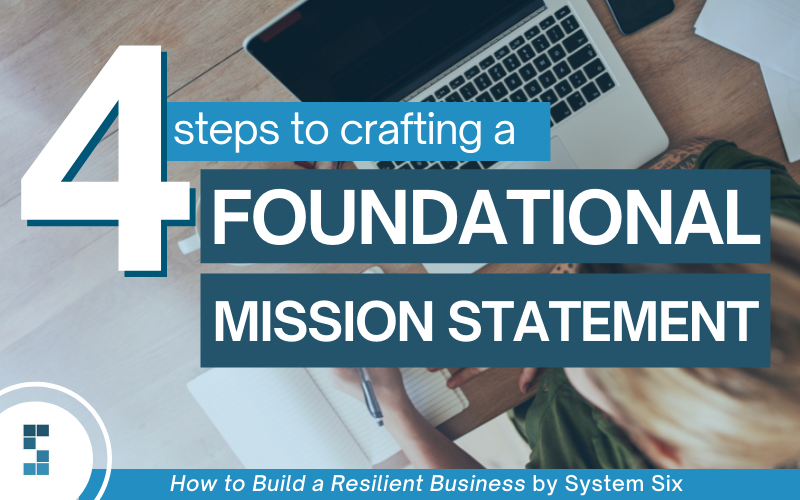
by Chris Williams | Jan 25, 2022 | Blog, Leadership
This past week, BlackRock CEO Larry Fink released his annual letter to investors. As a leader of one of the largest global investment firms, his words are powerful, poignant, and directive.
He wrote, “It’s never been more essential for CEOs to have a consistent voice, a clear purpose, a coherent strategy, and a long-term view. Your company’s purpose is its north star in this tumultuous environment.”
A resilient business is a successful business. A resilient business is a profitable business. A resilient business adds value and is valued by its stakeholders. A resilient business knows why it exists.
When it comes to business strategies, you have countless books and experts to choose from, covering all manner of topics. There is one strategy, however, that applies to any business, whether you are in the startup stage or are already an established company. That strategy is a well-crafted, written mission statement that clearly articulates your business’ mission, vision, and values.
Don’t be fooled into thinking it sounds too simple to carry so much weight. A well-written mission statement that encompasses who you are and where you are going provides a solid, resilient foundation from which to grow and work. It allows you to weather unexpected, tumultuous years with rooted security and unified vision.
So, what makes a great mission statement? And how do you go about creating one?
Here are 4 steps to crafting a foundational mission statement.
1. Check out the mission statements from companies you admire.
It’s likely that the companies you admire most already have really great mission statements.
Understandably, it can feel overwhelming to take stock of all your business ideas and develop a concise, clear answer to the “why” behind it all. If you feel hesitant or just stuck in this area, it can be constructive to take a close look at the companies you admire and would like to emulate.
Study their mission statements and identify what questions they are answering. Can you distill their mission, vision, and values from their credos? What resonates with your company? What doesn’t? What words and phrases invigorate and inspire you?
A great mission statement will clearly answer the questions of what your mission is, what your vision is, and what your core values are.
If you respect and admire a company, you’ll likely align with its mission, vision, and values as well. Take time to research the statements of these companies for inspiration.
2. Get away with your team.
It’s not uncommon for professional writers to retreat from the distractions and familiarity of their home and office when they need to get an important project finished. Even if writing isn’t part of your profession, we believe that taking that same kind of intentionality when creating your business’ mission statement can be immensely helpful.
Consider taking your team on a “writer’s retreat.” Getting out of the office and into an environment of quiet and rest can provide the right kind of setting to get your team’s collaborative, creative juices flowing.
Ask your team questions like “where are we going?” “What values are most important to us?” “What mission are we trying to accomplish?” Getting away from your day-to-day environment provides the mental breathing room to dig into these more profound questions.
Don’t forget to take thorough notes because these conversations will form the foundation for your mission statement.
3. Rework, refine, and write it down.
There’s a big difference between having your great ideas articulated in your head and actually writing them down.
The process of writing forces you to wrestle with and fine-tune your ideas into their most essential, easily understood forms. Like a sculptor who chisels away at all unnecessary stone until the final sculpture emerges, editing helps you chip away all the excess thoughts and words until you are left with the purest, most clearly defined ideas you want to convey.
This is a process that can’t be rushed. It will take time, intentionality, and, most likely, many re-workings to get just right. It is easy to pile words around a concept; brevity is always the challenge.
This process is not a “one-and-done” practice, however. Plan to regularly visit your statements to ensure you stay true to your mission and values.
4. Infuse your mission statement into your business practices.
Once you’ve got your mission statement written down, it should become your business’ “north star” to follow. Your mission statement should be what you and your team turn to when questions or disruptions inevitably arise. Your mission statement should also attract your customers and future employees.
As an example, one of SSB’s core values has always been the tried and true golden rule: “do unto others as you would have them do unto you.” This value has acted as our north star since our startup season around a kitchen table in Seattle. To this day, it is still a value that we check ourselves by as we work to grow, attract customers, retain employees, and create a rewarding workplace culture.
If we are missing the mark with a core value, we know we are not on track with our company’s mission. Instilling these values in your business will require frequent, habitual integration into your rhythms. Talk about them in leadership gatherings, include them in onboarding procedures and employee onboarding, review them in team meetings. If they only live as an aside on your website, they won’t infiltrate your company’s culture.
As you consider strategies to help grow your business from startup to success in 2022, we can’t encourage you strongly enough to prioritize a well-crafted mission statement. It may sound like a simple strategy, but we guarantee every hour of intention and work you put into clearly defining your mission, vision, and values will pay dividends as you endeavor to build your resilient business.
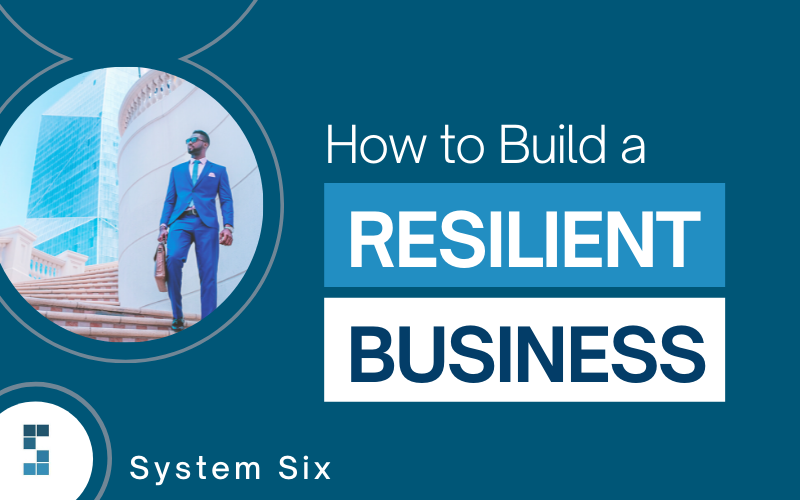
by Chris Williams | Jan 11, 2022 | Blog, Leadership
Whether you’re a brand new start-up, still dreaming and working from your kitchen table, or a more established, multi-million-dollar company with years of experience under your belt, resiliency is a quality you need to grow a successful business.
The Merriam-Webster Dictionary defines resilience as the ability to recover from or adjust easily to misfortune or change. Misfortune and change are apt words for the challenges every business will face (if they haven’t yet already in just the last two years alone.)
The bottom line: resiliency is more important than ever as we enter the unknowns of 2022.
We believe a resilient business is one that can stand the tests of time, change, and adversity. It’s building up from a strong foundation that anchors and lends stability in a constantly evolving world that presents unexpected challenges. A resilient foundation is necessary for successful, long-term growth.
At System Six Bookkeeping, we’ve been both the start-up working around a kitchen table and the multi-million dollar company. As we look back on our thirteen years of growth, we’ve identified three pillars that continue to move us from start-up to success: strategy, people, and execution.
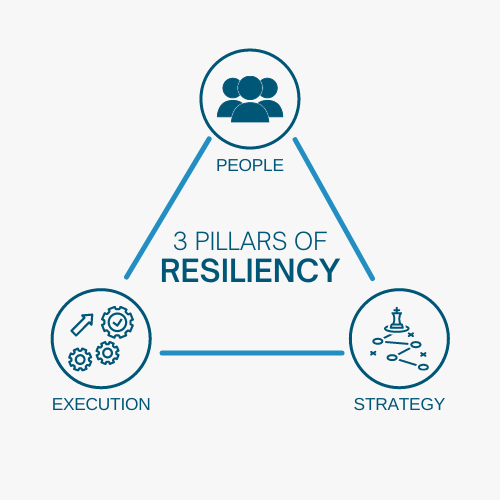
Strategy
There are countless books on countless strategies to consider when creating a successful business. Those strategies are worth exploring and implementing to help meet specific goals. Still, when we’re thinking about long-term resiliency, mission, vision, and values – specifically, the ability to clearly define them and keep them at the forefront of your company’s priorities – will be the most important strategies of all.
We all need a north star to follow, whether we are in the dreaming stage of building our business or are already leading a large, successful company. Don’t underestimate the value of being able to clearly define your business’ mission statement. It will support your vision of where you want to go and shape the values that you want your company to embody.
People
You can have the most inspiring, brilliantly worded mission statement in the world, and it will be 100% useless without people to live it out.
In order to build a resilient business, you need to attract and retain great people who are as passionate about your mission, vision, and values as you are.
There’s no denying that the workforce is rapidly changing. Twenty million employees quit their jobs in the second half 2021 alone. (Source: cbsnews.com) There are layers of factors for this, of course, but employee stress and burnout are high up on the list. Employers face the unprecedented double-challenge of trying to retain their employees and hire in an increasingly competitive environment.
People are your company’s greatest asset. One of the core values we at SSB strive to live by is to do unto others as you would have them do unto you. What do employees most value in today’s evolving culture? What do they need to feel valued and to be successful? It’s never been more important to consider these questions. In fact, Forbes claims that culture is a company’s single most powerful advantage. It not only has the power to increase sales exponentially (4x!), but fosters an environment to keep talented, committed employees that created this growth.
Execution
You’ve got your mission statement nailed down and amazing people to live it out with you – now, how do you go about getting the work done?
We believe resilient businesses have smart, efficient processes to keep communication and productivity consistent and well-organized. Your core values, as well as your desire for the well-being and success of your people, should be evident in the way you implement tools and processes that set you and your employees up for success.
There are many tools and services available to make this easier in 2022 – is your business up to date on the latest tools and technologies to take your productivity and organization to the next level?
Over the next couple of months, we are going to be taking a closer look at each of these pillars of strategy, people, and execution, and deep-dive into why we believe each of them is vital to building a resilient, successful business.


